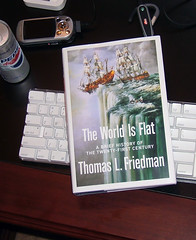
May 1, 2005
'The World Is Flat'
| |
No one ever gave me directions like this on a golf course before: "Aim at either Microsoft or IBM." I was standing on the first tee at the KGA Golf Club in downtown Bangalore, in southern India, when my playing partner pointed at two shiny glass-and-steel buildings off in the distance, just behind the first green. The Goldman Sachs building wasn't done yet; otherwise he could have pointed that out as well and made it a threesome. HP and Texas Instruments had their offices on the back nine, along the tenth hole. That wasn't all. The tee markers were from Epson, the printer company, and one of our caddies was wearing a hat from 3M. Outside, some of the traffic signs were also sponsored by Texas Instruments, and the Pizza Hut billboard on the way over showed a steaming pizza, under the headline "Gigabites of Taste!"
No, this definitely wasn't Kansas. It didn't even seem like India. Was this the New World, the Old World, or the Next World?
I had come to Bangalore, India's Silicon Valley, on my own Columbus-like journey of exploration. Columbus sailed with the Niña, the Pinta, and the Santa María in an effort to discover a shorter, more direct route to India by heading west, across the Atlantic, on what he presumed to be an open sea route to the East Indies-rather than going south and east around Africa, as Portuguese explorers of his day were trying to do. India and the magical Spice Islands of the East were famed at the time for their gold, pearls, gems, and silk-a source of untold riches. Finding this shortcut by sea to India, at a time when the Muslim powers of the day had blocked the overland routes from Europe, was a way for both Columbus and the Spanish monarchy to become wealthy and powerful. When Columbus set sail, he apparently assumed the Earth was round, which was why he was convinced that he could get to India by going west. He miscalculated the distance, though. He thought the Earth was a smaller sphere than it is. He also did not anticipate running into a landmass before he reached the East Indies. Nevertheless, he called the aboriginal peoples he encountered in the new world "Indians." Returning home, though, Columbus was able to tell his patrons, King Ferdinand and Queen Isabella, that although he never did find India, he could confirm that the world was indeed round.
I set out for India by going due east, via Frankfurt. I had Lufthansa business class. I knew exactly which direction I was going thanks to the GPS map displayed on the screen that popped out of the armrest of my airline seat. I landed safely and on schedule. I too encountered people called Indians. I too was searching for the source of India's riches. Columbus was searching for hardware-precious metals, silk, and spices-the source of wealth in his day. I was searching for software, brainpower, complex algorithms, knowledge workers, call centers, transmission protocols, breakthroughs in optical engineering-the sources of wealth in our day. Columbus was happy to make the Indians her met his slaves, a pool of free manual labor.
I just wanted to understand why the Indians I met were taking our work, why they had become such an important pool for the outsourcing of service and information technology work from America and other industrialized countries. Columbus had more than one hundred men on his three ships; I had a small crew from the Discovery Times channel that fit comfortably into two banged-up vans, with Indian drivers who drove barefoot. When I set sail, so to speak, I too assumed that the world was round, but what I encountered in the real India profoundly shook my faith in that notion. Columbus accidentally ran into America but thought he had discovered part of India. I actually found India and thought many of the people I met there were Americans. Some had actually taken American names, and others were doing great imitations of American accents at call centers and American business techniques at software labs.
Columbus reported to his king and queen that the world was round, and he went down in history as the man who first made this discovery. I returned home and shared my discovery only with my wife, and only in a whisper.
"Honey," I confided, "I think the world is flat." . . .


No comments:
Post a Comment